From humble beginnings to world leading: History of AFP Forensics
AFP Forensics has revolutionised the way crimes are solved in Australia but its beginnings can be traced back to two junior police officers who took it upon themselves to start up a forensic capability for ACT Police.
While AFP Forensics is now run out of a state-of-the-art facility in Canberra and throughout AFP commands across Australia, this National Science Week, the AFP is reflecting on its humble beginnings.
In its early decades, ACT Police had no scientific capability, however that changed in 1965 when Constable Ian Broomby and Constable Phil Baer formed the agency’s first Scientific Section. Constable Broomby spent time with other state police forces to build up his knowledge and later set up a fingerprint system which allowed fingerprints to be searched and potentially identified locally, before being sent to Sydney for expert examination.
Operational Science and Technology National Manager, Dr Simon Walsh said it was Constable Broomby who purchased the first general purpose microscope.
“By 1966, Constable Broomby and Constable Baer were using their one microscope to assist in bullet identification and tool mark comparisons,” Dr Walsh said.
“The new Scientific Section office was then built in the new City Police Station, and they were able to install a comparison microscope and bullet recovery tank to expand their operations”
The AFP was formed in 1979, and as part of that, there were recommendations for Forensic Science Laboratories and a Forensic Science Institute for research. AFP leadership made a commitment that the state of forensic science was to be examined and improved as an organisational priority.
“The establishment of the Forensic Research Unit at the ANU was revolutionary for the AFP, as this collaboration resulted in the invention of the Polilight, the now famous filtered light source that is able to detect fingerprints, bodily fluids and other evidence from crime scenes,” Dr Walsh said.
“This invention that changed modern day policing and revolutionised forensic science around the world.”
By the 1990s, the forensic remit was expanded to include firearms and ballistics, fingerprint research and chemical examination. A chemistry and biology laboratories were also established.
Also in this decade, 21st century database technology was introduced into the policing environment with the implementation of the national automated fingerprint Identification system (NAFIS) and national criminal investigation DNA database (NCIDD).
In 2002, Computer Forensics were integrated into the Forensics Command and established as an accredited forensic discipline. To this day, the AFP is one of only two agencies that hold accreditation in Digital Forensics (as it is now known).
In 2016, AFP Forensics relocated to the new Majura Forensics Facility in Canberra, where it thrives today.
“Our purpose-built facility is the most advanced of its kind in the Southern Hemisphere and provides infrastructure and workspaces to undertake joint forensic examinations supporting cross-agency investigations and collaborations,” Dr Walsh said.
“The facility sets the foundation for the AFP to continue to develop new science and support the changing nature of criminal investigations together with our domestic and international partners.
Today, AFP Forensics continues to push the boundaries, evolving to keep pace with new technologies, and to fight and disrupt crime in the physical and digital worlds.
Media enquiries:
AFP Media: (02) 5126 9297
Connect with us: Follow our Facebook, Twitter, LinkedIn, Instagram and YouTube pages to learn more about what the AFP does to keep Australia safe.

